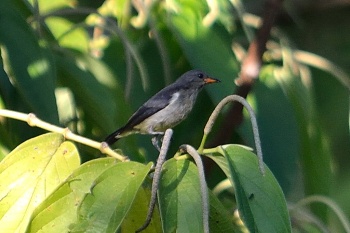(Sorted Taxonomy: thanks André) |
(Clearer main image. Picture of female. C/right. References updated) |
||
| Line 1: | Line 1: | ||
| + | [[Image:135 gs flower 2 cr sm.jpg|thumb|550px|right|Photo © by {{user|martinuk|martinuk}}<br />Lore Lindu National Park, Sulawesi, Indonesia, October 2009]] | ||
'''Alternative Name: Gray-sided Flowerpecker''' | '''Alternative Name: Gray-sided Flowerpecker''' | ||
| − | + | ||
;[[:Category:Dicaeum|Dicaeum]] celebicum | ;[[:Category:Dicaeum|Dicaeum]] celebicum | ||
==Identification== | ==Identification== | ||
| + | [[Image:IMG 27822.jpg|thumb|350px|right|Female, subspecies ''celebicum''<br />Photo © by {{user|julienl|julienl}}<br />Gunung Ambang, Sulawesi, Indonesia, May 2018]] | ||
9 cm, 3.5 inches | 9 cm, 3.5 inches | ||
====Male==== | ====Male==== | ||
| − | |||
*[[Topography Artwork Heads|Crown]] and upperparts black with purple [[Dictionary G-L#I|iridescence]] | *[[Topography Artwork Heads|Crown]] and upperparts black with purple [[Dictionary G-L#I|iridescence]] | ||
*Blackish face | *Blackish face | ||
| Line 17: | Line 18: | ||
*Black legs | *Black legs | ||
====Female==== | ====Female==== | ||
| + | [[Image:Dicaeum celebicum fy 2014 2.jpg|thumb|350px|right|Juvenile<br />Photo © by {{user|codexluminati|codexluminati}}<br />Manado, [[Sulawesi]], [[Indonesia]],January 2014]] | ||
*Grey-brown upperparts | *Grey-brown upperparts | ||
*Whitish-grey on throat and breast | *Whitish-grey on throat and breast | ||
| Line 31: | Line 33: | ||
====Subspecies==== | ====Subspecies==== | ||
There are 5 subspecies<sup>[[#References|[1]]]</sup>: | There are 5 subspecies<sup>[[#References|[1]]]</sup>: | ||
| − | |||
*''D. c. celebicum'': | *''D. c. celebicum'': | ||
| − | :*Manadotua, Bangka, Sulawesi, Lembeh, Togian, Muna and Butung Islands | + | :*Manadotua, Bangka, [[Sulawesi]], Lembeh, Togian, Muna and Butung Islands |
*''D. c. talautense'': | *''D. c. talautense'': | ||
:*Talaud Island, north [[Moluccas]] | :*Talaud Island, north [[Moluccas]] | ||
| Line 52: | Line 53: | ||
Repetitive, weak and upslurred “seeei”, short, reiterated “tjjt”, short, dry, subdued “trri-tri”, and a high “tsip”; flight call is an abrupt “chip, chip, chip…” | Repetitive, weak and upslurred “seeei”, short, reiterated “tjjt”, short, dry, subdued “trri-tri”, and a high “tsip”; flight call is an abrupt “chip, chip, chip…” | ||
==References== | ==References== | ||
| − | #{{Ref- | + | #{{Ref-Clements6thAug17}}#Avibase |
#Handbook of the Birds of the World Alive (retrieved November 2015) | #Handbook of the Birds of the World Alive (retrieved November 2015) | ||
{{ref}} | {{ref}} | ||
Latest revision as of 22:39, 15 July 2018
Alternative Name: Gray-sided Flowerpecker
- Dicaeum celebicum
Identification
9 cm, 3.5 inches
Male
- Crown and upperparts black with purple iridescence
- Blackish face
- White throat
- Bright red patch on lower throat and breast
- Belly yellowish-white with black central line
- Black-green flanks
- Off white undertail coverts
- Dark iris
- Dark brown beak
- Black legs
Female
- Grey-brown upperparts
- Whitish-grey on throat and breast
- Grey green flanks
- Centre of belly and vent dull yellowish-white
Juvenile
- Similar to female but darker underparts
- Greener on upper breast
- Darker, greyer throat
- Lighter beak
Distribution
Sulawesi, some adjacent islands, Banggai and Sulu islands and Talaud islands, Indonesia.
Taxonomy
Subspecies
There are 5 subspecies[1]:
- D. c. celebicum:
- Manadotua, Bangka, Sulawesi, Lembeh, Togian, Muna and Butung Islands
- D. c. talautense:
- Talaud Island, north Moluccas
- D. c. sanghirense:
- Sangihe and Siau islands, off northern Sulawesi
- D. c. sulaense:
- Banggai and Sula Islands. (Taliabu, Mangole and Sanana)
- D. c. kuehni:
- Tukangbesi Archipelago (off Sulawesi)
Habitat
Montane, lowland primary and tall secondary forest, forest edge, plantations, cultivation, gardens and secondary scrub; Up to 1200 m.
Behaviour
Diet
Fruits, nectar and pollen of mistletoes, wild cherries and Lantana camara, small spiders and insects. Forages mainly in the upper canopy. Gleans bare outer twigs. Forages alone and in pairs.
Breeding
Nest is pear-shaped, with or without a covered entrance on the side towards the top. woven out of down and fine grasses, adorned with twigs, spider silk and leaf debris. It is suspended 1.5–2 m above ground from an outer branch. 3 white eggs.
Vocalisation
Repetitive, weak and upslurred “seeei”, short, reiterated “tjjt”, short, dry, subdued “trri-tri”, and a high “tsip”; flight call is an abrupt “chip, chip, chip…”
References
- Clements, J. F., T. S. Schulenberg, M. J. Iliff, D. Roberson, T. A. Fredericks, B. L. Sullivan, and C. L. Wood. 2017. The eBird/Clements checklist of birds of the world: v2017, with updates to August 2017. Downloaded from http://www.birds.cornell.edu/clementschecklist/download/
- Avibase
- Handbook of the Birds of the World Alive (retrieved November 2015)
Recommended Citation
- BirdForum Opus contributors. (2025) Grey-sided Flowerpecker. In: BirdForum, the forum for wild birds and birding. Retrieved 12 May 2025 from https://www.birdforum.net/opus/Grey-sided_Flowerpecker






